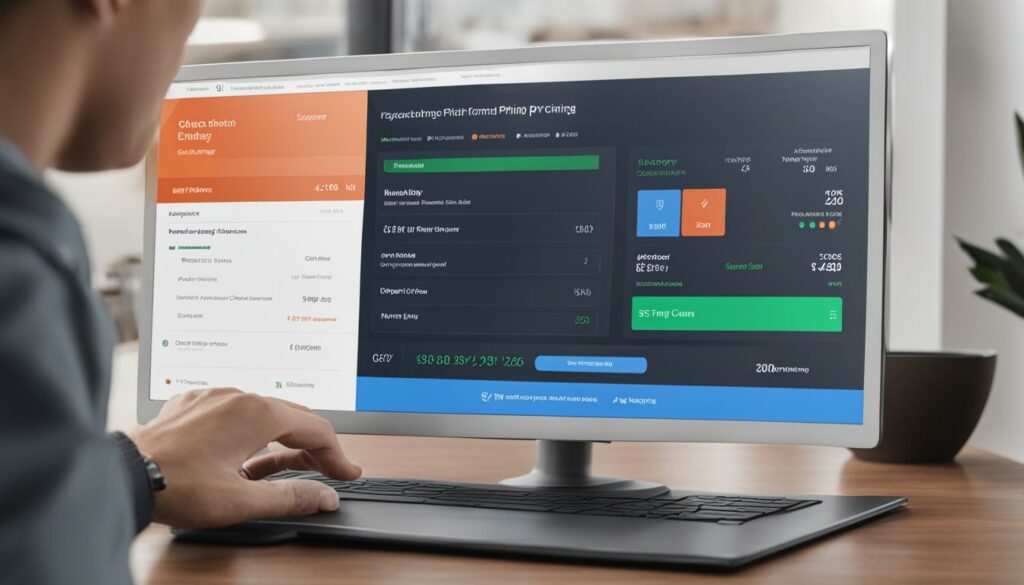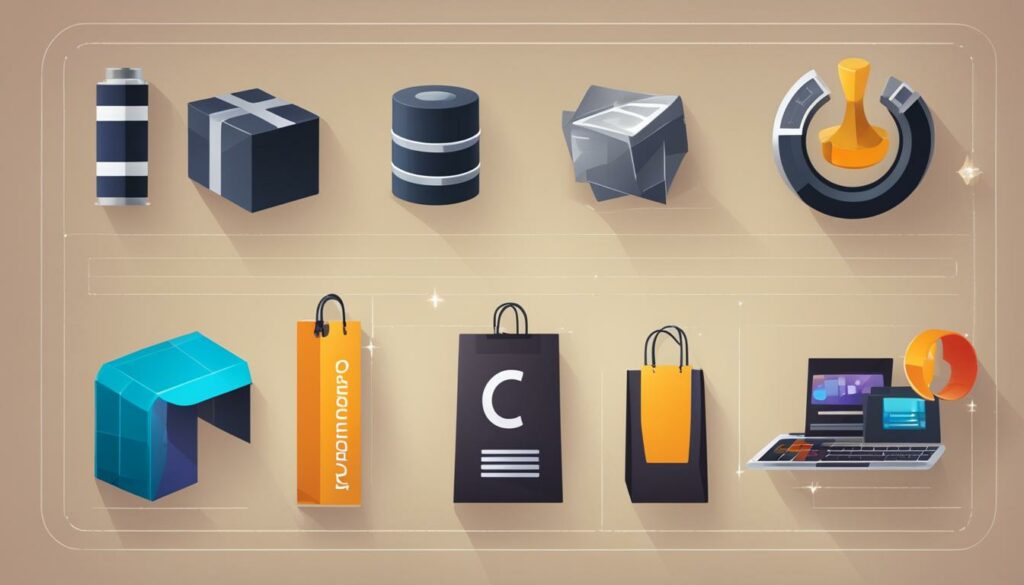Are you ready to optimize your e-commerce site’s performance? Mastering the basics of WordPress is the key to success. With the right e-commerce solutions and WordPress monitoring tools, you can track website performance, monitor uptime, speed, and security, and gain real-time insights with WordPress analytics. BoostedHost offers recommended WordPress Hosting for optimal performance, ensuring your online business thrives. Sign up now through this link and take your e-commerce game to the next level: www.boostedhost.com/wordpress-hosting.
Key Takeaways:
- WordPress Monitoring tools help you track website performance.
- Real-time monitoring of website uptime, speed, and security is crucial for e-commerce success.
- WordPress analytics provide valuable insights into your website’s performance.
- BoostedHost offers recommended WordPress Hosting to optimize your e-commerce site.
- Sign up now to take advantage of these e-commerce solutions and achieve online success.
Installing WooCommerce
WooCommerce is a popular WordPress plugin that allows you to set up and optimize your e-commerce venture. With WooCommerce, you can create a seamless and efficient online store that meets your business requirements.
To install WooCommerce, follow these simple steps:
- Login to your WordPress dashboard.
- Go to the “Plugins” section.
- Click on “Add New”.
- In the search bar, type “WooCommerce”.
- Click on the “Install Now” button next to the WooCommerce plugin.
- Once the installation is complete, activate the plugin.
After activating WooCommerce, you will be guided through the setup process using the built-in WooCommerce setup wizard. This wizard will help you configure important settings such as your store location, currency, and product types. This ensures that your online store is tailored to your specific business needs.
During the setup process, you can easily define your store’s location, choose the currency you want to use, and specify the types of products you will be selling. This makes it easy for customers to browse your store and make purchases in a familiar currency.
How to set up WooCommerce:
1. Store Location: Select the country and address where your store is based. This is important for tax calculations and shipping settings.
2. Currency: Choose the currency you want to use for your store. This ensures that prices are displayed in the right currency for your customers.
3. Product Types: Determine the types of products you will be selling in your store, such as physical products, digital downloads, or both.
Once you’ve completed the setup process, you’ll be ready to start adding products and customizing your online store to create a unique and engaging shopping experience for your customers.
Setting up WooCommerce is quick and easy. With just a few clicks, you can transform your WordPress website into a powerful e-commerce platform. The WooCommerce setup wizard simplifies the process of getting your store up and running, making it accessible to beginners and experienced users alike.
Adding Products
Once WooCommerce is active, you can start adding products to your online store. Utilizing WooCommerce’s user-friendly interface, you can create product listings that include essential details such as images, descriptions, prices, and inventory information. Managing your product catalog becomes effortless, allowing you to provide a seamless shopping experience for your customers.
Adding products to WooCommerce is a straightforward process. Follow these steps to ensure a hassle-free experience:
- Log in to your WordPress dashboard.
- Navigate to the WooCommerce tab in the sidebar.
- Click on “Products” to access the product management section.
- Click on the “Add New” button to create a new product listing.
- Fill in the necessary details for your product:
| Field | Description |
|---|---|
| Product Name | Enter the name of your product. |
| Description | Write a compelling description to entice your customers. |
| Price | Set the price at which you are selling the product. |
| Inventory | Enter the stock quantity and manage inventory details. |
| Images | Add high-quality product images to showcase your merchandise. |
Once you have filled in the necessary information, don’t forget to save your product. Repeat these steps for each product you wish to add to your WooCommerce store.
Managing your Product Catalog
WooCommerce provides a comprehensive set of tools for efficiently managing your product catalog. You can easily view, edit, and organize your products in one place. Some key features include:
- Bulk edit: Make changes to multiple products simultaneously, saving you time and effort.
- Categories and tags: Organize your products into different categories and assign relevant tags for efficient browsing.
- Product variations: Create different variations of your products, such as size and color options.
With WooCommerce, you have the flexibility and control to showcase and manage your products effectively. Keep your product catalog up to date and ensure a seamless shopping experience for your customers.
Selecting Payment Gateways
When it comes to running an e-commerce store on WooCommerce, one crucial aspect to consider is the selection of payment gateways. Payment gateways ensure secure transactions and provide a seamless checkout process for your customers. With WooCommerce, you have access to a wide range of payment options, including credit cards and PayPal, among others.
To choose the right payment methods for your store, it’s essential to consider your target audience and their preferences. Some customers may prefer paying with their credit cards, while others may prefer the convenience of using platforms like PayPal. By offering multiple payment options, you increase the chances of capturing a broader customer base.
Remember that security is of utmost importance when it comes to payment gateways. Ensure that the selected gateways adhere to industry-standard security protocols to safeguard sensitive customer information. This will foster trust and confidence in your online store, further boosting customer satisfaction and loyalty.
Now, let’s take a closer look at some popular payment gateways supported by WooCommerce:
1. Credit Cards
Accepting credit card payments is a must for any e-commerce store. WooCommerce integrates seamlessly with leading processors like Stripe and Authorize.Net, making it easy to securely process credit card transactions. By leveraging the power of credit cards, you can provide a convenient payment option for your customers.
2. PayPal
PayPal is a widely recognized and trusted payment method for online transactions. It offers a seamless checkout experience and allows customers to pay using their PayPal balance or linked bank accounts and credit cards. By enabling PayPal as a payment option, you cater to customers who prefer using this platform for their online purchases.
3. Other Payment Gateways
Besides credit cards and PayPal, WooCommerce supports numerous other payment gateways, such as Apple Pay, Google Pay, and Amazon Pay. These gateways provide additional convenience for customers who already have accounts with these platforms, simplifying the checkout process further.
Remember, choosing payment gateways is a decision that should align with both your customers’ needs and your business goals. Prioritize secure transactions, provide diverse payment options, and allow your customers to pay in the way they feel most comfortable.
Here’s an image summarizing the popular payment gateways supported by WooCommerce:
Setting Up Shipping Options
When it comes to running an e-commerce venture, setting up shipping options is a crucial step in ensuring a smooth customer experience. With WooCommerce, you have the flexibility to configure shipping methods and rates that align with your specific business model. Whether you offer flat rates, free shipping, or more complex shipping options based on location, weight, or dimensions, WooCommerce has got you covered.
By providing various shipping methods, you give your customers the freedom to choose the option that best suits their needs. Some customers may prefer faster shipping methods, while others may be more price-conscious and opt for slower but more cost-effective shipping. With WooCommerce, you can cater to both preferences and ensure customer satisfaction.
If you offer flat rates, customers will know exactly what to expect when it comes to shipping costs. This can be particularly beneficial for businesses that sell similar-sized or weighted products. On the other hand, offering free shipping can be a powerful sales strategy to attract customers. By absorbing the shipping costs into the product prices, you can enhance the perceived value of your offerings and entice customers to make a purchase.
For businesses with more complex shipping requirements, WooCommerce provides advanced options to calculate shipping rates based on location, weight, or dimensions. This allows you to provide accurate shipping costs to your customers, ensuring transparency and avoiding any surprises during the checkout process.
Now, let’s take a look at some of the shipping options available in WooCommerce:
Flat Rates:
Create a flat rate shipping option that applies to all products or specific product categories. This provides a consistent shipping cost regardless of the quantity or value of the items in the cart.
Free Shipping:
Set up free shipping for certain products, specific locations, or minimum order amounts. This can be a powerful marketing tool to attract customers and boost sales.
Table Rate Shipping:
Define shipping rates based on a comprehensive table of rules, such as weight, dimensions, destination, and more. This allows for precise calculations and tailored shipping costs based on specific variables.
Real-Time Calculated Shipping:
Integrate your WooCommerce store with shipping carriers such as UPS and FedEx to provide real-time shipping rates based on the customer’s location and the weight and dimensions of the products being shipped.
Having a seamless shipping process is essential for customer satisfaction and can contribute to repeat purchases and positive reviews. With WooCommerce’s robust shipping options, you can find the perfect balance between affordability and reliability, ultimately driving the success of your e-commerce business.
Example: Setting Up Flat Rate Shipping
Let’s walk through an example of how to set up flat rate shipping in WooCommerce:
- From your WordPress dashboard, navigate to WooCommerce and click on “Settings”.
- Select the “Shipping” tab.
- Click on “Shipping Zones” and choose the zone you want to configure flat rate shipping for.
- Click on the “+ Add Shipping Method” button.
- Choose “Flat Rate” from the dropdown menu.
- Enter a name for the shipping method (e.g., “Standard Shipping”).
- Set the cost for this shipping method (e.g., $5.00).
- Configure any additional settings, such as taxable status or the availability of the shipping method.
- Click “Save Changes”.
Once you’ve completed these steps, your customers will see the flat rate shipping option during the checkout process, and the shipping cost will be added to their total order amount.
Remember, shipping methods and rates can greatly impact your e-commerce business, so take the time to evaluate your options and choose the best solution for your specific needs. With WooCommerce’s comprehensive shipping features, you have the opportunity to provide an exceptional shipping experience that keeps your customers coming back.

Customizing the Design
Make your online store visually appealing and user-friendly by customizing the design in WooCommerce. When it comes to enhancing the look and feel of your website, customizing the design elements such as themes, colors, fonts, and layouts plays a crucial role. By carefully selecting the right combination of these design elements, you can create a unique and seamless shopping experience that aligns with your brand identity and captivates your customers.
Start by choosing a theme that best represents your brand and resonates with your target audience. WooCommerce offers a wide range of themes, both free and premium, that cater to various industries and design preferences. Take your time to browse through the available options and select the one that complements your products or services and aligns with your brand persona.
Once you’ve selected a suitable theme, it’s time to customize the colors, fonts, and layouts to match your brand identity. Use the built-in customization options in WooCommerce or leverage CSS coding to fine-tune the visual elements. By selecting the right color palette and font combinations, you can evoke specific emotions and create a cohesive brand experience across your website.
Adjusting Colors
Colors play a crucial role in creating an aesthetically pleasing and memorable online store. Adjusting the colors to match your brand identity is essential for creating a cohesive and visually appealing experience. Consider your brand’s color scheme and choose hues that align with your logo, products, and target audience. Pay attention to the psychological impact of colors and their ability to evoke certain emotions. For example, warm colors like red and orange can create a sense of urgency or excitement, while cool colors like blue and green can provide a calming effect.
Choosing Fonts
Selecting the right fonts for your online store can significantly impact the readability and overall user experience. Consider your brand’s personality and choose fonts that reflect its tone and style. Opt for easy-to-read fonts for body text and use more decorative fonts for headlines and other attention-grabbing elements. Strike a balance between aesthetics and functionality by ensuring that the chosen fonts are legible across different devices and screen sizes.
Customizing Layouts
Customizing the layout of your online store allows you to create a unique and intuitive browsing experience for your customers. Experiment with different layouts, such as grid or list views, to find the one that best showcases your products and enhances user engagement. Consider the user journey and prioritize ease of navigation, clear product descriptions, and prominent calls-to-action. A well-designed layout can guide customers through your store effortlessly and increase the likelihood of conversions.
Customizing the design in WooCommerce gives you the power to create a visually stunning online store that leaves a lasting impression on your target audience. Take the time to carefully select themes, adjust colors and fonts, and customize layouts to reflect your brand personality and provide a seamless shopping experience.
Adding Essential Plugins
Enhance the functionality of your WooCommerce store by installing essential plugins. These plugins are designed to optimize various aspects of your online business, from search engine visibility to targeted marketing efforts, and website performance analysis. By leveraging the power of WooCommerce plugins, you can take your e-commerce venture to the next level.
SEO Plugins for Better Search Engine Visibility
Improve your website’s search engine rankings with dedicated SEO plugins. These plugins provide tools and features that allow you to optimize your content, meta tags, and URLs. They also generate XML sitemaps to facilitate search engine crawling and indexing. Boost your online visibility and attract organic traffic with popular SEO plugins like Yoast SEO and All in One SEO Pack.
Email Marketing Integrations to Reach Your Target Audience
An effective email marketing strategy is crucial for engaging with your customers and driving conversions. Integrate your WooCommerce store with email marketing plugins to automate email campaigns, segment your audience, and personalize your messages. Popular email marketing plugins like Mailchimp, Constant Contact, and Klaviyo provide seamless integration with WooCommerce, ensuring you can effortlessly nurture leads and boost sales.
Analytics Tools to Monitor Website Performance
Gain valuable insights into your website’s performance and customer behavior with analytics plugins. These tools help you track key metrics such as traffic, conversion rates, and revenue. By analyzing this data, you can make data-driven decisions to optimize your marketing strategies and website design. Popular analytics plugins for WooCommerce include Google Analytics and MonsterInsights.
| Plugin | Description |
|---|---|
| Yoast SEO | A comprehensive SEO plugin that provides on-page optimization features, including keyword analysis and content suggestions. |
| All in One SEO Pack | An alternative SEO plugin that offers similar functionality to Yoast SEO, ensuring your website is optimized for search engines. |
| Mailchimp | A popular email marketing platform that seamlessly integrates with WooCommerce, allowing you to automate email campaigns and build customer relationships. |
| Constant Contact | An email marketing tool that enables you to create stunning emails and newsletters, and send them to your WooCommerce customer base. |
| Klaviyo | A powerful email marketing solution specifically designed for e-commerce businesses, providing advanced segmentation and personalization capabilities. |
| Google Analytics | A comprehensive web analytics tool that tracks and analyzes website traffic, user behavior, and conversions for WooCommerce stores. |
| MonsterInsights | A user-friendly Google Analytics plugin that simplifies data tracking and reporting, providing actionable insights for your WooCommerce store. |
By incorporating these essential plugins into your WooCommerce setup, you can optimize your online store for better search engine visibility, reach your target audience through effective email marketing, and gain valuable insights into your website’s performance. Explore the vast range of WooCommerce plugins available and select the ones that best align with your business goals and objectives.

Testing and Optimization
Before launching your WooCommerce store, it is crucial to thoroughly test its functionality to ensure a seamless shopping experience for your customers. By checking the various aspects of your website and optimizing its performance, you can create a user-friendly environment that encourages conversions.
Testing WooCommerce Functionality
Begin by examining the key features of your WooCommerce store to ensure they are working as intended. Test the following aspects:
- Adding products to the cart
- Updating and removing products from the cart
- Applying coupon codes
- Calculating shipping costs accurately
- Processing payments through different gateways
By meticulously testing these functionalities, you can identify and fix any issues that may arise, guaranteeing a smooth user experience.
Checking Links
Broken links can be frustrating for users and negatively impact your website’s performance. Use a link checker tool to scan your WooCommerce store and ensure all links are functioning correctly. This includes:
- Navigation menus
- Internal links within product descriptions or blog posts
- External links to social media profiles or partner websites
Fix any broken links promptly to maintain a seamless browsing experience for your customers.
Optimizing Site Speed
Site speed is a crucial factor in user satisfaction and SEO ranking. Optimizing your WooCommerce store’s speed ensures a seamless browsing experience. Here are some tips to improve site speed:
- Optimize images by compressing them without compromising quality
- Utilize a caching plugin to store frequently accessed data and reduce load times
- Minify CSS and JavaScript files to reduce file size
- Use a content delivery network (CDN) to distribute your website’s content globally
Mobile Responsiveness
In today’s mobile-dominated world, it is crucial to have a mobile-responsive e-commerce store. Test your WooCommerce site on different devices and screen sizes to ensure it adapts well. Pay attention to:
- Button and layout placement for easy navigation
- Image scaling and loading speed
- Responsiveness of dropdown menus and form fields
Smooth Checkout Process
A streamlined checkout process minimizes cart abandonment and increases conversions. Test your WooCommerce store’s checkout process to ensure it is user-friendly and efficient. Consider:
- Reducing the number of required form fields
- Offering guest checkout options
- Providing clear instructions and error messages
- Testing different payment gateways to ensure smooth transactions
By optimizing your site for mobile responsiveness and providing a smooth checkout process, you create a positive experience that encourages customers to complete their purchases.
Summary of Testing and Optimization
| Aspect | Testing Steps | Optimization Tips |
|---|---|---|
| Functionality | Thoroughly test key features: adding/removing products, applying coupons, calculating shipping, processing payments | Fix any issues identified during testing to ensure a smooth user experience |
| Links | Scan your website for broken links in navigation menus, internal content, and external references | Regularly check and fix broken links to maintain a seamless browsing experience |
| Site Speed | Optimize images, leverage caching plugins, minify files, and use CDN for faster loading times | Regularly monitor and optimize site speed to improve user experience and SEO rankings |
| Mobile Responsiveness | Test your store on different devices and screen sizes to ensure proper display and functionality | Ensure buttons, images, and forms adapt well and provide a seamless mobile browsing experience |
| Smooth Checkout Process | Test the checkout process, reducing form fields, offering guest checkout, and testing payment gateways | Streamline the checkout process to minimize cart abandonment and increase conversions |
Launch and Market
Once you’re satisfied with your WooCommerce setup, it’s time to launch your e-commerce store. But launching your store is just the beginning; you need a solid marketing plan to drive traffic to your online store and increase sales. Here are some essential strategies:
- Social Media Promotion: Leverage the power of social media platforms to showcase your products, interact with customers, and build brand awareness. Create engaging content, run targeted ads, and collaborate with influencers to reach your target audience.
- Email Marketing: Build a subscriber list and implement email marketing campaigns to nurture customer relationships, promote new products or offers, and drive repeat purchases. Personalize your emails and provide value to your subscribers.
- Search Engine Optimization (SEO): Optimize your e-commerce store for search engines to improve your organic rankings and increase visibility. Conduct keyword research, optimize product descriptions and meta tags, and build high-quality backlinks to boost your search engine presence.
“Social media promotion, email marketing, and search engine optimization are crucial components of a successful e-commerce marketing strategy.”
Comparison of Marketing Strategies
| Marketing Strategy | Advantages | Disadvantages |
|---|---|---|
| Social Media Promotion |
|
|
| Email Marketing |
|
|
| Search Engine Optimization |
|
|
Implementing these strategies in your marketing plan will help you create a buzz around your e-commerce store, attract potential customers, and drive conversions. Remember to analyze the results regularly and refine your marketing efforts based on customer feedback and data insights.
Monitor and Improve
E-commerce success is an ongoing journey. To ensure the continuous growth of your online store, it is crucial to monitor and improve its performance regularly.
One of the most effective ways to monitor website performance is by utilizing WordPress monitoring tools. These tools provide valuable insights into various performance metrics, such as website uptime, speed, and security. By keeping a close eye on these metrics, you can identify any issues or bottlenecks that may impact your customers’ experience and take proactive measures to address them.
Besides monitoring tools, analytics play a vital role in understanding your website’s performance. By leveraging WordPress analytics, you can gain valuable insights into your audience’s behavior, traffic sources, and popular products. This data empowers you to make data-driven decisions and optimize your store accordingly.
Customer feedback is another valuable resource for improving your online store. Actively listen to your customers’ feedback, whether it’s through reviews, surveys, or social media interactions. By addressing their concerns and implementing their suggestions, you can enhance the user experience and build stronger relationships with your customers.
Regular updates are crucial to keeping your online store fresh and engaging. Continuously evaluate your product offerings, and add new items to cater to changing market trends or customer demands. By regularly updating your store, you can keep your customers interested and encourage them to come back for more.
“The only way to do great work is to love what you do.” – Steve Jobs
Remember, e-commerce success is not a one-time effort but an ongoing commitment to monitor, analyze, and improve. By utilizing WordPress monitoring tools, analyzing data, listening to customer feedback, and regularly updating your store, you can create a seamless and satisfying shopping experience for your customers and drive your online business towards greater success.
Why Monitoring and Improvement Matter
Monitoring your website performance and continuously improving it is crucial for several reasons:
- Enhanced User Experience: Monitoring and addressing performance issues ensure that your website operates smoothly, providing an optimal user experience.
- Increased Conversion Rates: A well-performing website with fast load times and secure transactions boosts customer trust, leading to higher conversion rates.
- Competitive Advantage: By regularly monitoring and improving your website, you can stay ahead of the competition and attract more customers.
- Business Growth: Continuous improvement allows you to identify and capitalize on opportunities to grow your online business.
The Benefits of Mastering WordPress
Mastering WordPress offers numerous benefits for individuals and businesses. By gaining proficiency in this powerful content management system, you can unlock a world of possibilities for website creation and management. Whether you’re an aspiring entrepreneur or a seasoned professional, developing your WordPress skills can empower you to take control of your online presence and achieve your goals.
Valuable Skill Development
Learning WordPress is a valuable skill set in the digital age. With its user-friendly interface and extensive customization options, WordPress allows you to create stunning websites without the need for coding knowledge. By mastering WordPress, you can harness the power of this versatile platform to showcase your creativity, enhance your digital presence, and attract a wider audience.
Cost-Effective Website Creation and Management
WordPress offers cost-effective solutions for website creation and management. Unlike hiring web developers or investing in expensive website builders, mastering WordPress enables you to independently create, maintain, and update your website with minimal costs. With a wide range of free and premium themes, plugins, and resources available, you can customize your website to suit your branding and business needs without breaking the bank.
Empowering Entrepreneurs
For entrepreneurs, mastering WordPress provides a sense of empowerment. It allows you to have full control over your online business, from the design and functionality of your website to the implementation of various e-commerce features. With WordPress, you can easily manage product listings, payment gateways, shipping options, and other essential elements of your online store, empowering you to run your business with confidence and efficiency.
If you’re just starting, enrolling in a WordPress course can help beginners lay the foundation for website creation. These courses provide step-by-step guidance on setting up and customizing WordPress websites, ensuring you have the necessary skills to create a strong online presence.
For those already familiar with WordPress, advanced courses offer deeper insights into customization options and troubleshooting knowledge. These courses cater to individuals looking to enhance their existing WordPress skills and take their websites to the next level.
Overall, mastering WordPress opens up a world of opportunities for individuals and businesses alike. It’s a skill that empowers you to create and manage websites cost-effectively, develop your digital presence, and unleash your entrepreneurial potential. Embrace the power of WordPress and start your journey towards success today.

Conclusion
WordPress is the ultimate solution for creating and managing a successful online presence. With the right e-commerce tools and a mastery of WordPress, you can optimize your website’s performance and achieve e-commerce success. By harnessing the power of WordPress, you can elevate your online presence, boost your brand’s visibility, and drive growth in the digital landscape.
Enrolling in a WordPress course is a crucial step in personal and professional growth. Through comprehensive training, you’ll gain the knowledge and skills necessary to navigate the world of WordPress with confidence. From website creation to customization, a WordPress course equips you with the expertise to build and manage exceptional websites that captivate your audience.
Don’t miss out on the opportunity to unlock the full potential of your online presence. Embrace WordPress and enroll in a WordPress course today. Whether you’re an individual looking to enhance your skills or a business aiming to thrive in the digital arena, WordPress offers the perfect platform for success.
FAQ
Q: What is the importance of WordPress monitoring?
A: WordPress monitoring allows you to track website performance, monitor uptime, speed, and security, and gain real-time insights into your website’s performance. It helps optimize your e-commerce site for better user experience and business success.
Q: How do I install WooCommerce?
A: To install WooCommerce, go to the WordPress dashboard and navigate to “Plugins.” Click on “Add New,” search for WooCommerce, and install and activate the plugin. The WooCommerce setup wizard will guide you through the process of configuring essential settings for your online store.
Q: How can I add products to my WooCommerce store?
A: To add products to your WooCommerce store, use the user-friendly interface provided by the plugin. Create product listings with images, descriptions, prices, and inventory details to manage your product catalog efficiently and provide a seamless shopping experience for your customers.
Q: What payment gateways can I use with WooCommerce?
A: WooCommerce supports a wide range of payment options, including credit cards, PayPal, and more. Choose suitable payment methods that cater to your target audience and ensure secure transactions on your e-commerce store.
Q: How can I set up shipping options in WooCommerce?
A: Configure shipping methods and rates in WooCommerce based on your business model. Whether you offer flat rates, free shipping, or more complex shipping options based on location, weight, or dimensions, WooCommerce provides the flexibility to meet your e-commerce venture’s shipping needs.
Q: Can I customize the design of my WooCommerce store?
A: Yes, you can customize the design of your WooCommerce store to make it visually appealing and user-friendly. Select an appropriate theme that matches your brand identity and customize elements such as colors, fonts, and layouts to create a unique shopping experience for your customers.
Q: What are essential plugins I should consider for my WooCommerce store?
A: Essential plugins for your WooCommerce store may include SEO plugins for better search engine visibility, email marketing integrations to reach your target audience, and analytics tools to monitor website performance and gain insights into customer behavior.
Q: How do I test and optimize my WooCommerce store?
A: Before launching your WooCommerce store, thoroughly test its functionality. Ensure that all links work, the checkout process is smooth, and payment gateways function correctly. Optimize your site for speed and mobile responsiveness to provide an excellent user experience and increase conversions.
Q: How can I effectively launch and market my e-commerce store?
A: Create a comprehensive marketing plan that includes social media promotion, email marketing campaigns, and search engine optimization strategies. These efforts will help drive traffic to your online store and increase sales.
Q: How do I monitor and improve my WooCommerce store?
A: Utilize WordPress monitoring tools and analytics to continuously monitor your website’s performance. Pay attention to customer feedback and make improvements based on their experiences. Regularly update your product offerings to keep your store fresh and engaging.
Q: What are the benefits of mastering WordPress?
A: Mastering WordPress provides a valuable skillset in the digital age, allows for cost-effective website creation and management, and empowers entrepreneurs to independently control their online presence. It offers personal and professional growth opportunities and is essential for e-commerce success.
Q: How can I enroll in a WordPress course?
A: To enroll in a WordPress course, you can search for reputable online platforms or educational institutions that offer WordPress courses. Look for courses that cater to your skill level, whether you are a beginner or advanced user. These courses can provide the necessary knowledge and skills to master WordPress.
Source Links
- https://www.linkedin.com/pulse/mastering-woocommerce-step-by-step-guide-e-commerce-success-zayn-butt
- https://medium.com/@josh4853334/mastering-wordpress-a-comprehensive-guide-for-beginners-0f17b2a561bf
- https://www.elegantthemes.com/blog/tips-tricks/e-commerce-tips-for-making-your-wordpress-store-a-success












